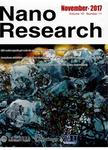Electrochemical Performance and ex situ Analysis of ZnMn2O4 Nanowires as Anode Materials for Lithium Rechargeable Batteries
Electrochemical Performance and ex situ Analysis of ZnMn2O4 Nanowires as Anode Materials for Lithium Rechargeable Batteries作者机构:Research Institute of Advanced Materials Seoul National University 599 Kwanak-ro Kwanak-gu Seoul 151-742 Republic of Korea Department of Materials Science and Engineering Korea Advanced Institute of Science and Technology 335 Gwahangno Yuseong-gu Daejeon 305-701 Republic of Korea Department of Materials Science and Engineering Korea Advanced Institute of Science and Technology 335 Gwahangno Yuseong-gu Daejeon 305-701 Republic of Korea Department of Materials Science and Engineering Seoul National University 599 Kwanak-ro Kwanak-gu Seoul 151-742 Republic of Korea
出 版 物:《Nano Research》 (纳米研究(英文版))
年 卷 期:2011年第4卷第5期
页 面:505-510页
核心收录:
学科分类:081702[工学-化学工艺] 08[工学] 0817[工学-化学工程与技术] 080502[工学-材料学] 0805[工学-材料科学与工程(可授工学、理学学位)]
基 金:This research was supported by the Energy Resource Technology Development program the Energy Resources Technology R&D program under the Ministry of Knowledge Economy. This research was also supported by the Nuclear R&D program Engineering Research Center program 韩国科学与工程基金(KOSEF) This research was also supported by the National Research Foundation of Korea Grant funded by the Korean Government (MEST) The Support Program for the Advancement of National Research Facilities and Equipment”, funded by the Korean government (MEST) H. W. L. was supported by the NRF of Korea Grant funded by MEST
主 题:Energy storage lithium rechargeable battery anode ZnMn204 nanowire
摘 要:One-dimensional ZnMn2O4 nanowires have been prepared and investigated as anode materials in Li rechargeable batteries. The highly crystalline ZnMn2O4 nanowires about 15 nm in width and 500 nm in length showed a high specific capacity of about 650 mAh.g-1 at a current rate of 100 mA.g-1 after 40 cycles. They also exhibited high power capability at elevated current rates, i.e., 450 and 350 mAh.g 1 at current rates of 500 and 1000 mA.g 1, respectively. Formation of Mn3O4 and ZnO phases was identified by ex situ X-ray diffraction (XRD) and transmission electron microscopy (TEM) studies after the initial discharge-charge cycle, which indicates that the ZnMn2O4 phase was converted to a nanocomposite of Mn3O4 and ZnO phases immediately after the electrochemical conversion reaction.



